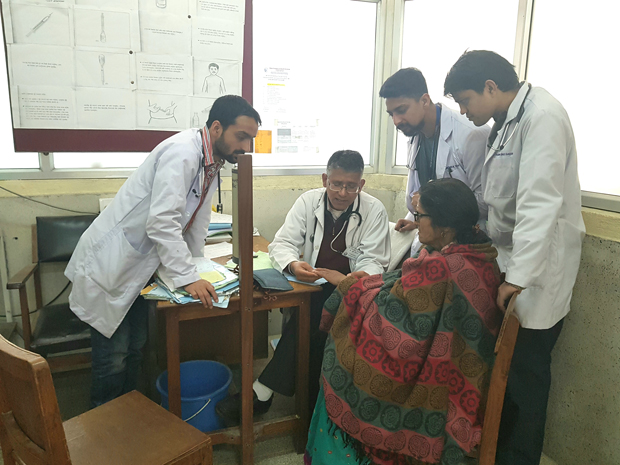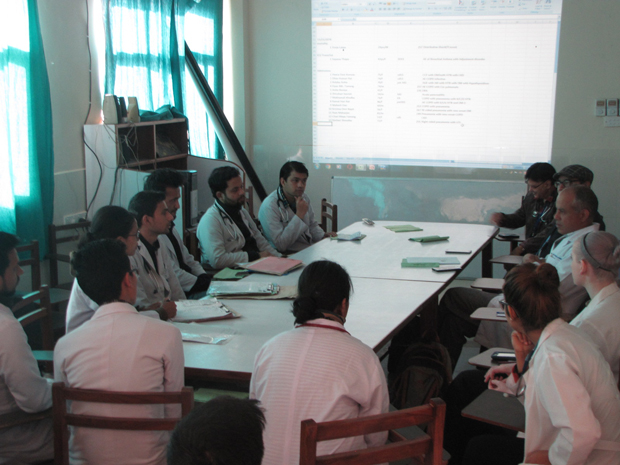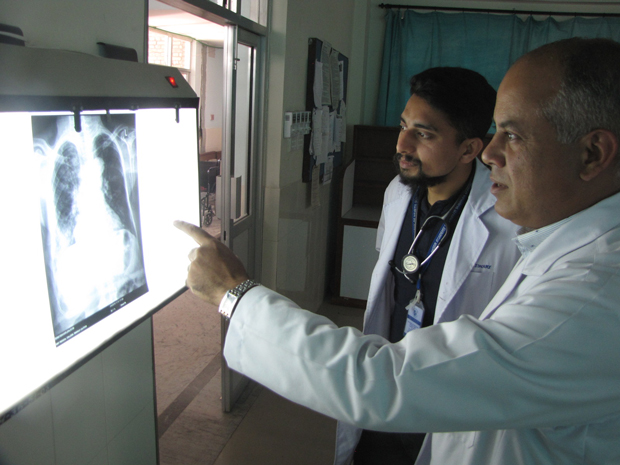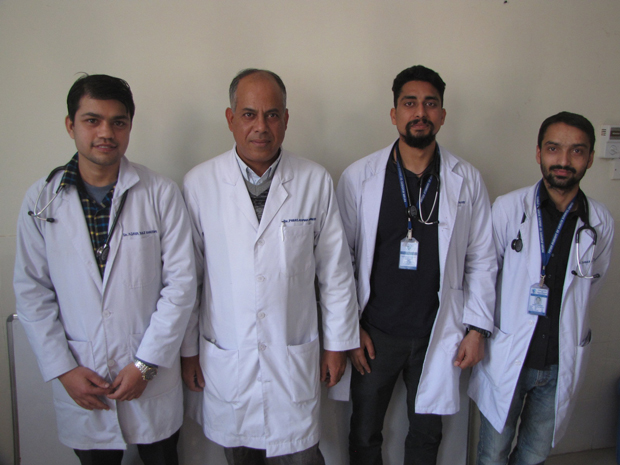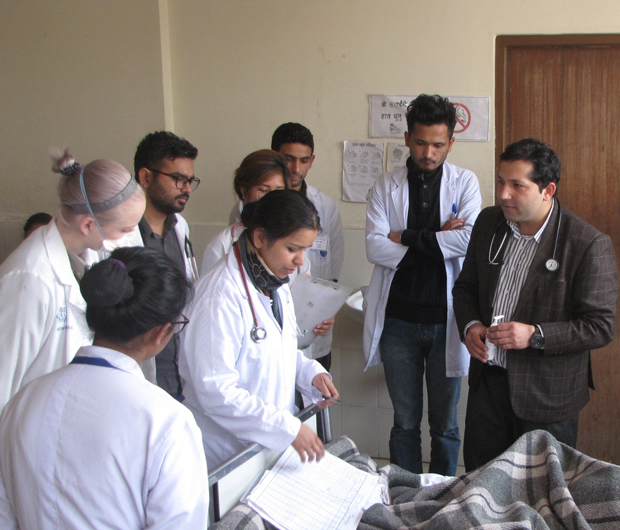New internal medicine residency gains foothold in Nepal
Patan Hospital of Nepal, a tertiary-level referral center that treats nearly 320,000 outpatients and 20,000 inpatients each year, began an internal medicine residency program last year.
Starting an internal medicine residency in Nepal may not be as tall an order as scaling Mount Everest, but it took several years of work to get the nascent program at Patan Academy of Health Sciences (PAHS) off the ground.
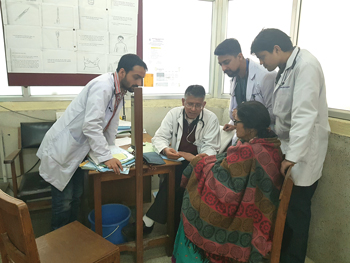
PAHS and its teaching hospital, Patan Hospital, are located just south of Kathmandu, Nepal's capital city. “Patan Hospital is an interesting place because it's the second oldest and the second biggest hospital in the country,” said Theodore MacKinney, MD, MPH, FACP, who has volunteered regularly in Nepal since 1993 and began teaching at the hospital around 2000.
In 2006, Patan Hospital shifted from being a missionary hospital to a government one, he explained. “The people that continued to work there were still quite committed to the values of taking care of poor people and teaching high-quality service, so the hospital has tried to maintain that distinction,” said Dr. MacKinney, who is an associate professor at Medical College of Wisconsin in Milwaukee.
Patan Hospital, a tertiary-level referral center that treats nearly 320,000 outpatients and 20,000 inpatients each year, serves people from every district of Nepal, from the remote villages to the Kathmandu Valley, said Buddhi Paudyal, MD, a professor of medicine at PAHS. “The mission of Patan Hospital is to provide quality, compassionate health care to everyone who comes to the hospital, regardless of their ability to pay,” he said.
Although the hospital retained its service- and education-driven values, it had no internal medicine residency program until last year. Faculty members explained how they developed the new program and detailed the fundamental differences between medicine in the U.S. versus Nepal, one of the poorest countries in the world.
The history of internal medicine in Nepal spans less than 50 years, originating with the addition of trained physicians from the U.K. and India, explained Dr. Paudyal. Nepal offered no internal medicine training programs until the early 1990s, beginning at the Valley Group of Hospitals and expanding to other public and private medical schools in subsequent years, he said.
The PAHS residency program held its first entrance examination in September 2017. “Hundreds of aspirants sat for the examination. There were three residency seats in the internal medicine program, so three were admitted,” said Dr. Paudyal. At the same time, other disciplines also filled residency slots: three in pediatrics, three in obstetrics-gynecology, three in surgery, two in orthopedics, and seven in general practice/family medicine, he said.
The modest crop of new residents took time to cultivate. It was originally the dream and vision of Arjun Karki, MD, the first vice-chancellor of PAHS, to develop a full competency-based internal medicine training program, Dr. MacKinney said. “He was the one who originally invited me to come help move the process forward,” he said.
Educators had set their sights on developing the internal medicine residency in 2011, but the process was not as quick as expected due to administrative barriers, said Dr. MacKinney. “The Nepal Medical Council said, ‘You cannot start a residency until your first medical school class has graduated and finished their internship year,’” he said. PAHS, the medical school, had opened in 2008 and wouldn't be producing its first undergraduate physicians until 2015.
Delayed yet undeterred, Dr. MacKinney worked with an academic committee in academic year 2014-2015 to help plan rotating internships for the medical school's first graduating class. The class collectively aced its Nepal Medical Council Licensing Examination, a key test new physicians take after their internship, he said. “I think the national pass rate is about 70%, and every single [intern] passed … which made people pretty happy,” said Dr. MacKinney.
The next step was to develop the proper internal medicine residency. While Dr. MacKinney left the country to return to the U.S., colleague Mark Zimmerman, MD, senior faculty at PAHS, “took the basic strategy and materials we had and was able to work with Nepal colleagues to bring things together,” Dr. MacKinney said.
Over about six months in 2017, the faculty of the medicine department, led by Paras Acharya, MD, internal medicine residency program director, and Dr. Zimmerman, met regularly to develop a competency-based curriculum. The program and its diverse learning methods were based on Patan Hospital's pre-existing family medicine curriculum and on several U.S. residency programs, said Dr. Zimmerman.
He first came to Nepal in 1986, expecting to volunteer only for a few months, but has become a mainstay at PAHS. “The majestic land, warm-hearted people, and amazing medicine in Patan Hospital nudged me to stay longer, and now I've wound up spending my whole career here,” he said. “When I arrived here, I could count all of Nepal's fully qualified internists on two hands.”
PAHS is dedicated to producing socially responsible physicians, and the new internal medicine residency involves a rotation in a rural area, said Dr. Zimmerman. “Three months of the internal medicine residency training will take place in a rural government hospital, and graduates of the three-year program will be bonded to serve in government hospitals for at least another three years,” he said.
During the rural rotation, residents will be closely supervised by both local preceptors and PAHS faculty, Dr. Paudyal said. Each resident will also organize a health camp away from his or her usual rural health setting, providing free medical services to communities in need. “We believe that this will be a great opportunity for the residents to work in [a] resource-limited setting away from their standard teaching hospital setting,” he said. “Similarly, the community will get specialist care, which was nonexistent in the past.”
Sudeep Adhikari, MBBS, a first-year resident from Tanahun District in Central Nepal, said he decided to pursue a career in internal medicine because of the critical thinking and problem solving involved. He noted that the PAHS residency program is different than those at other institutions in Nepal or in neighboring countries. “It's a competency-based curriculum based on formative assessment, so I am excited for this residency program,” said Dr. Adhikari.
Competency-based training is not a foreign concept for U.S. programs, but in Nepal, past residency programs would graduate residents based more on completion than competency, explained Dr. MacKinney. “[PAHS] is trying to say, ‘You have to put in your time, and you have to demonstrate these basic competencies for an internist,’ so they're developing appropriate checklists and systems,” he said.
To help support the new residency, ACP donated 12 subscriptions to its Medical Knowledge Self-Assessment Program (MKSAP) to faculty. “We expect to make good use of the generous gift of the MKSAP subscriptions as material for small group discussions, a source for nonexam questions, and for our own continuing professional development,” said Dr. Zimmerman.
While MKSAP doesn't delve deeply into diseases patients might contract in Nepal, such as typhoid fever and Japanese encephalitis, the residents also need to master standard Western conditions like coronary artery disease and ventilator-associated pneumonia, which are front and center in the resource, Dr. MacKinney added. “We're very thankful for that. … The straight internal medicine that you get in MKSAP is material that they need,” he said.
Looking forward, internal medicine training in Nepal must continue to grow to meet the needs of its people, said Dr. Paudyal. “We need to increase the slots for internal medicine residency in all possible hospitals to increase the number of qualified primary care physicians. At the same time, we need to develop training programs in internal medicine subspecialty subjects,” he said, adding that PAHS is considering starting a fellowship program in rheumatology in a year or two.
In addition, writing will be a crucial skill for the new internal medicine residents, from penning letters to the editor to publishing articles in peer-reviewed journals, said Buddha Basnyat, MD, FACP, a consultant physician and researcher at Patan Hospital who is also affiliated with the Centre for Tropical Medicine and Global Health at the University of Oxford in England. “The South Asian culture is exclusively about learning by rote, and this needs to be disrupted by encouraging these residents to write so that the PAHS internal medicine program becomes a useful trendsetter in the region,” he said.

